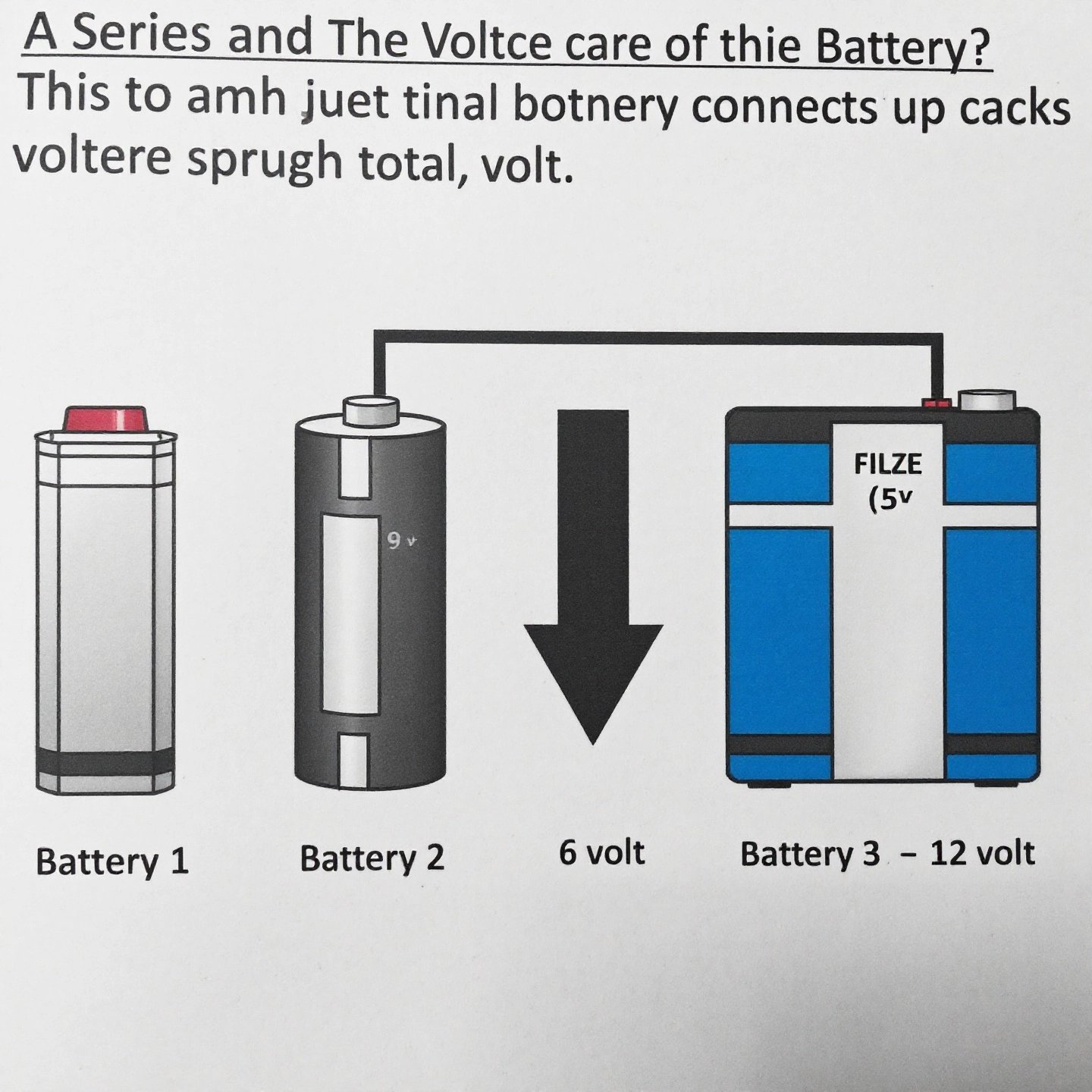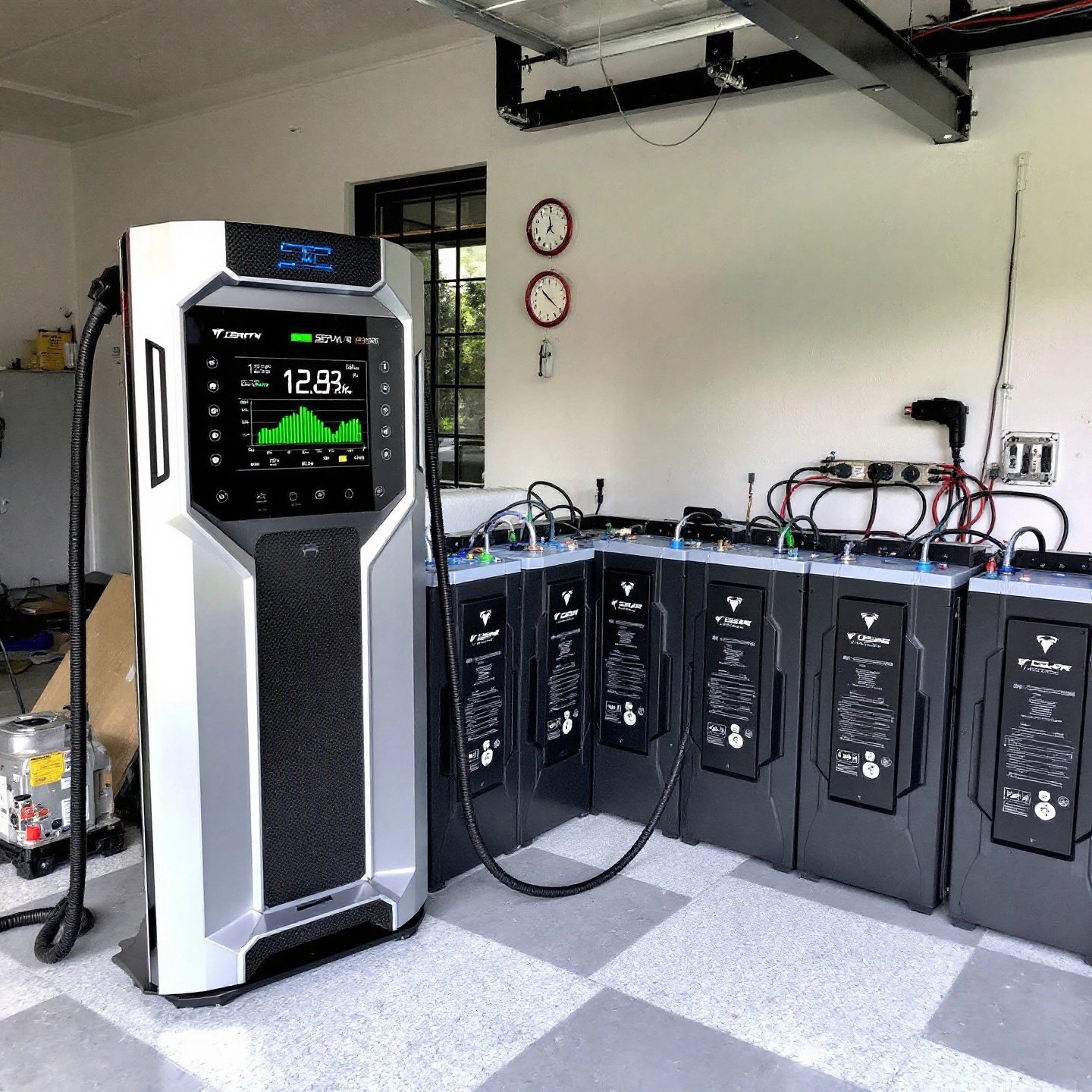Introduction to Battery in Series
When it comes to powering devices and systems that require higher voltage, understanding the concept of a battery in series is essential. But what exactly does this mean? In simple terms, connecting batteries in series involves linking the positive terminal of one battery to the negative terminal of the next. This configuration increases the total voltage output while the current remains constant. Imagine needing a power supply for an electric vehicle or a high-power tool—this is where series connections become invaluable.
Why should you care about batteries in series? For starters, they allow you to increase voltage with series batteries to meet specific power demands. This setup is particularly beneficial in applications that require a higher voltage than a single battery can provide. For instance, in electric vehicles, multiple batteries are often connected in series to achieve the necessary voltage to power the motor efficiently. Similarly, in renewable energy systems, such as solar power setups, series configurations help in achieving the desired voltage levels to match inverter specifications.
Throughout this article, we will guide you through the essentials of batteries in series, from understanding their basic configuration to exploring their advantages and potential applications. Whether you’re a beginner looking to grasp the fundamentals or an enthusiast eager to optimize your power systems, this structured approach will provide you with the insights needed to harness the full potential of series battery connections. So, let’s dive deeper into the world of series batteries and unlock the power possibilities they offer.
Understanding Batteries in Series
When you connect multiple batteries in a series, you effectively create a batteries in series configuration that boosts the overall voltage of the system while maintaining a constant current. The principle behind this setup is straightforward: by linking the positive terminal of one battery to the negative terminal of the next, the voltages of each battery add together. This is akin to stacking batteries end-to-end, where the voltage potential accumulates, enabling devices to operate at higher voltages than a single battery could provide.
Consider a scenario where you’re powering an electric vehicle or a high-performance tool. These applications often require more voltage than a single battery can supply. By using a series battery setup, you can achieve the necessary voltage to power these devices efficiently. For instance, connecting four 12-volt batteries in series results in a combined output of 48 volts, crucial for applications that demand higher operational voltage.
This configuration is not just beneficial but sometimes necessary in various high-voltage systems. In renewable energy setups, such as solar power installations, batteries in series are commonly used to match the voltage requirements of inverters, ensuring optimal energy conversion and storage. Similarly, in telecommunications and data centers, where uninterrupted power supply is critical, series configurations help maintain consistent voltage levels required for reliable operation.
It’s important to note that while the voltage increases, the capacity (measured in ampere-hours, Ah) remains unchanged in a series configuration. This means that although you gain higher voltage, the runtime or the total energy capacity of the system does not increase. Therefore, understanding the balance between voltage requirements and energy capacity is crucial when designing power systems using series battery setups.
In summary, the strategic use of batteries in series can unlock significant power potential, making it an essential consideration for anyone looking to optimize their power supply systems for higher voltage applications. As we move forward, we’ll delve deeper into the electrical theory behind series connections and explore how to effectively harness their capabilities.

Voltage and Current Essentials
Understanding the electrical theory behind series connections is crucial for anyone looking to optimize their power systems. When connecting batteries in series, the voltage of each battery adds up, while the current remains the same throughout the circuit. This is the fundamental principle that allows for higher voltage outputs without altering the current capacity, a concept essential for powering devices that require a higher voltage than a single battery can provide.
Voltage in Series Connections
In a series battery voltage configuration, the total voltage is the sum of the voltages of each individual battery. For example, if you connect three 12-volt batteries in series, the total output will be 36 volts. This principle is particularly useful in applications where a higher voltage is necessary, such as in electric vehicles or renewable energy systems. The cumulative voltage allows for more powerful and efficient operation without needing to increase the current.
Current in Series Connections
Despite the increase in voltage, the current in series connection remains consistent across all components. This is because there is only one path for the current to flow, meaning the same amount of current passes through each battery. This characteristic is essential for maintaining the integrity of the circuit and ensuring that each component receives the same current, preventing potential damage or inefficiencies.
Understanding the Relationship with Ohm’s Law
Ohm’s Law, which states that V = IR (voltage equals current times resistance), plays a pivotal role in understanding series circuits. In a series setup, the total resistance is the sum of individual resistances, which affects the overall current flow. For example, if the total resistance increases, the current will decrease if the voltage remains constant. This relationship is crucial for designing circuits that can handle specific power requirements without overloading components.
Comparing Series and Single Battery Outputs
| Configuration | Total Voltage | Total Current |
|---|---|---|
| Single 12V Battery | 12V | 5A |
| Three 12V Batteries in Series | 36V | 5A |
This table illustrates how connecting batteries in series increases the voltage while maintaining the same current. Understanding these principles helps in designing efficient power systems that meet specific voltage and current requirements.
As we move forward, we’ll explore how series configurations compare to parallel setups, highlighting the unique advantages and considerations of each.
Series vs Parallel Configurations
When deciding between series vs parallel batteries, it’s essential to understand how each configuration impacts your power system. Both setups have distinct advantages and are suited to different applications, depending on whether you need increased voltage or greater capacity. Let’s delve into the battery configuration comparison to see which might best meet your needs.
Pros and Cons of Series Configurations
In a series configuration, connecting batteries increases the total voltage while the current remains unchanged. This setup is particularly beneficial for applications requiring higher voltage outputs, such as electric vehicles or high-power tools. For instance, connecting two 12V batteries in series results in a 24V output, making it ideal for systems needing more voltage to operate efficiently.
Pros:
- Increased voltage output without altering the current, suitable for high-voltage applications.
- Simplifies the power system design by avoiding the need for voltage converters.
Cons:
- The capacity (ampere-hour) remains the same, which may not extend the runtime.
- Any failure in one battery can disrupt the entire series, as the current path is singular.
Pros and Cons of Parallel Configurations
Conversely, a parallel setup increases the overall capacity (ampere-hour) while keeping the voltage constant. This configuration is ideal for applications where extended battery life is crucial, such as in backup power systems or devices that require long-term energy supply without frequent recharging.
Pros:
- Increased capacity leads to longer runtime, beneficial for devices needing sustained power.
- Redundancy: If one battery fails, others can continue supplying power, enhancing reliability.
Cons:
- Voltage remains unchanged, which may not be suitable for high-voltage applications.
- Requires thicker cables due to higher current draw, potentially complicating installation.
Choosing the Right Configuration
The decision between wiring batteries in series vs parallel ultimately depends on your specific power needs. If your application demands higher voltage, a series configuration is the way to go. However, if extended battery life is more critical, then a parallel setup would be more advantageous. It’s also possible to combine both configurations in a series-parallel arrangement to simultaneously increase both voltage and capacity, offering a flexible solution for complex power systems.
As we continue, we’ll explore the necessary preparation steps for safely connecting batteries in series, ensuring you have the knowledge to optimize your power systems effectively.

Preparation Steps for Safe Connections
Before diving into the process of connecting batteries in series, ensuring a safe battery connection is paramount. Proper preparation not only safeguards your equipment but also protects you from potential hazards. Here’s a comprehensive guide on the essential safety measures, tools, and materials you’ll need to get started.
Essential Safety Measures
First and foremost, prioritize safety by wearing appropriate personal protective equipment (PPE). This includes insulated gloves and safety goggles to protect against accidental sparks or battery acid spills. Working in a well-ventilated area is also crucial to prevent the accumulation of hazardous gases.
Understanding polarity is vital in avoiding short circuits. Always connect the positive terminal of one battery to the negative terminal of the next. Missteps in polarity can lead to severe damage or even explosions, underscoring the importance of double-checking connections before proceeding.
Tools and Materials Required
- Jumper Cables: Use appropriately sized cables that can handle the increased voltage without overheating. The cable size should match the current rating to ensure efficiency and safety.
- Multimeter: This tool is essential for testing voltage levels and ensuring all connections are correct before powering the system.
- Battery Holders: Secure the batteries in place to prevent movement that could disrupt connections or cause short circuits.
- Diagram or Labeling System: Create a clear diagram or label each connection to avoid confusion, especially in larger setups.
Integrating Solar Solutions
For those looking to expand their battery bank within a clean energy system, integrating solar solutions can be a seamless process. Well-chosen solar products, such as those from Renewable Energy Nexus, can complement your series setup by providing sustainable power sources that reduce reliance on traditional energy grids.
By following these preparation steps, you’ll ensure a battery series safety that not only meets your power needs but also aligns with best practices for safe and efficient energy use. As we proceed, we’ll explore the actual wiring techniques required for connecting multiple batteries in series.
Wiring Techniques for Multiple Batteries
Connecting batteries in series may sound complex, but with the right approach, it becomes straightforward and manageable. Here, we’ll guide you through the essential steps to connect batteries in series, ensuring you achieve the desired voltage increase without compromising safety or efficiency.
Step-by-Step Guide to Series Battery Wiring
- Step 1: Gather Your Materials
Before starting, ensure you have all necessary tools and materials: a multimeter for voltage testing, appropriately sized jumper cables, and battery holders to secure your setup. - Step 2: Safety First
Wear protective gear such as insulated gloves and safety goggles. Ensure your workspace is well-ventilated to avoid the accumulation of gases released by batteries. - Step 3: Prepare the Batteries
Ensure that all batteries are of the same type, voltage, and capacity. This uniformity prevents imbalances that could lead to performance issues or safety hazards. - Step 4: Connect the Batteries
Begin by connecting the positive terminal of the first battery to the negative terminal of the second battery. Continue this pattern for each subsequent battery. The last battery’s negative terminal will serve as the system’s negative output, and the first battery’s positive terminal will be the positive output. - Step 5: Label and Color-Code
Use labels or color-coded wires to clearly identify each connection point. This step is crucial for troubleshooting and ensures that any future maintenance is straightforward. - Step 6: Test the Voltage
After connecting all batteries, use a multimeter to test the total voltage of the series. This ensures that the connection is correct and that the system is balanced. For instance, if you have connected three 12V batteries, the multimeter should read approximately 36V.
Ensuring Efficiency and Safety
While the process of series battery wiring is relatively simple, attention to detail is critical. Each connection must be secure to prevent any voltage drop or inefficiency in the system. Regularly check for signs of wear or corrosion on connectors and cables, as these can lead to resistance increases and potential failures.
By following these steps, you’ll ensure a reliable series configuration that meets your power needs. As we move forward, we’ll explore common issues that may arise with series connections and how to troubleshoot them effectively.
Common Issues and Troubleshooting
When working with batteries in series, certain challenges can arise that may affect the overall performance and longevity of your power system. One common issue is uneven battery discharge, where some batteries deplete faster than others, leading to imbalanced voltage levels. This can occur due to variations in battery quality, age, or capacity, and if left unchecked, it can shorten the lifespan of the entire battery bank.
Identifying and Resolving Uneven Discharge
To address battery series troubleshooting related to uneven discharge, regularly monitor the voltage of each battery using a multimeter. If you notice significant discrepancies, consider rotating the batteries within the series to promote even wear. Additionally, investing in a battery balancer can help equalize the charge among all batteries, ensuring consistent performance.
Fluctuating Voltage Readings
Another issue is fluctuating voltage readings, which can indicate poor connections or faulty batteries. Start by inspecting all connections for corrosion or looseness, as these can increase resistance and lead to voltage drops. Clean terminals with a wire brush and ensure all connections are tight. If fluctuations persist, test each battery individually to identify any underperforming units that may need replacement.
Maintenance Routines for Optimal Performance
Regular series battery maintenance is crucial for preventing issues. Implement a routine that includes cleaning battery terminals, checking electrolyte levels (for lead-acid batteries), and ensuring proper ventilation to avoid overheating. Schedule periodic equalization charges to balance the charge across all cells, which can help prevent sulphation and extend battery life.
For large-scale setups, advanced diagnostic tools and resources can offer deeper insights into battery health. Services like Renewable Energy Nexus provide professional guidance and tools that can help maintain your system’s efficiency and reliability.
By addressing these common issues and implementing proactive maintenance routines, you can significantly enhance the performance and longevity of your series battery setup. As we continue, the next focus will be on effective charging methods to ensure your batteries are always ready to deliver optimal power.

Charging Methods for Series Systems
Charging batteries connected in series requires a strategic approach to ensure efficiency and longevity. When dealing with charging series batteries, it’s crucial to use the right equipment and methods to prevent overvoltage and maintain balance across the battery bank.
Using a Single Series Battery Charger
For simplicity and effectiveness, a single charger that matches the total voltage of the battery bank is recommended. For example, if you have two 12V batteries in series, a 24V charger is ideal. This method ensures that both batteries receive equal charging and helps prevent imbalances that could lead to uneven wear or reduced capacity over time. Using a single charger also minimizes the risk of overvoltage, as it regulates the power input to match the combined voltage of the batteries.
Precautions to Prevent Imbalance
Before connecting the batteries in series, ensure each battery is fully charged individually. This step balances the state of charge (SOC) across all batteries, which is crucial for maintaining uniform performance. Once balanced, connect the batteries in series and use the appropriate series battery charger. Regularly monitor the voltage of each battery during and after charging to detect any discrepancies early. If an imbalance is detected, disconnect the batteries and charge them individually to restore balance.
Charging Two 12V Batteries in Series
When charging two 12V batteries in series, a single 24V charger is the most efficient option. This setup ensures that both batteries charge evenly, preventing one from being overcharged while the other remains undercharged. If using two separate 12V chargers, ensure they are synchronized to avoid imbalances. However, this method is generally less reliable than using a single charger designed for the total voltage of the system.
For those considering larger setups, such as with renewable energy systems, ensure that your charging equipment is compatible with the higher voltage outputs. This may involve using specialized chargers that can handle the increased voltage and provide consistent power delivery. By following these guidelines, you can effectively manage and maintain your series battery system, ensuring it delivers optimal performance and longevity.
Maintenance Tips for Long-Term Performance
To ensure the longevity and optimal function of your battery system, regular battery series maintenance is crucial. By keeping a close eye on several key aspects, you can avoid common pitfalls and extend the life of your batteries significantly.
Regular Inspections and Cleaning
One of the most important maintenance tasks is the regular inspection and cleaning of battery terminals and cables. Corrosion can build up over time, leading to poor connections and diminished performance. Use a wire brush soaked in a mixture of baking soda and water to clean any deposits from the terminals. After cleaning, apply a thin layer of anti-corrosive spray or silicon gel to prevent future corrosion. This routine not only ensures a good connection but also helps prevent electrical issues and extends battery life.
Ensuring Cable Integrity
Check and tighten battery cable connections regularly to avoid loose connections, which can cause inefficiencies or even failure. Inspect cables for any signs of wear or damage, replacing them as necessary to maintain a robust connection. This step is vital to ensure that your batteries receive the proper electrical flow, preventing unnecessary strain on the system.
Monitoring Voltage and Seasonal Checkups
Regularly monitor the voltage across each battery to ensure balanced performance. This practice helps identify any imbalances early, allowing for corrective measures before they lead to more significant issues. Seasonal checkups are also recommended, especially after harsh weather conditions that can affect battery performance. During these checkups, verify that all components are functioning correctly and make any necessary adjustments.
Proper Storage Guidelines
If your batteries will be unused for extended periods, proper storage is essential to prevent damage. Store lead-acid batteries in a cool, dry place, and ensure they are fully charged every 3 to 6 months to maintain their performance. For lithium-ion batteries, store them at a partial state of charge, ideally between 40% to 50%, and avoid extreme temperatures to prolong their lifespan. These practices are part of essential long-term battery care that safeguards your investment and ensures your system is ready when you need it.
By adhering to these maintenance tips, you can significantly enhance the performance and longevity of your battery series setup. As we conclude, we’ll summarize the key insights and encourage exploring advanced system expansions for greater energy independence.
Conclusion: Unlocking the Full Potential of Battery Series Configurations
As we wrap up our exploration of battery in series configurations, it’s clear that understanding how to properly wire multiple batteries can significantly enhance the efficiency and functionality of your power systems. By boosting voltage through series connections, you can meet specific power demands, making this setup ideal for high-voltage applications such as electric vehicles and renewable energy systems.
Safety remains paramount when handling battery systems. Ensuring proper connections, using the right tools, and adhering to safety protocols prevents accidents and prolongs battery life. Regular maintenance, such as inspecting terminals for corrosion and ensuring balanced voltage across batteries, is crucial for sustained performance.
Charging approaches also play a critical role. Using a charger that matches the total voltage of your series setup helps maintain balance and prevents overvoltage, which can damage batteries. Attention to detail in these areas ensures your battery system operates at peak efficiency.
For those looking to expand their power systems, integrating solar panels offers a sustainable path forward. Platforms like Renewable Energy Nexus provide a range of solar solutions that can seamlessly complement your battery series setup, promoting clean energy independence and reducing reliance on traditional power grids.
By embracing these strategies, you not only optimize your current energy setup but also open the door to innovative renewable solutions. Staying informed and curious about advancements in battery and solar technologies can lead to more efficient, eco-friendly energy systems that align with a sustainable future.
Frequently Asked Questions
1. How do batteries in series increase voltage?
Batteries in series increase voltage by connecting the positive terminal of one battery to the negative terminal of the next. This configuration adds the voltage of each battery together, providing a higher total voltage output while maintaining the same current.
2. What are the benefits of using batteries in series?
Using batteries in series allows for higher voltage outputs, which are essential for applications like electric vehicles and renewable energy systems. This setup simplifies power system design by avoiding the need for voltage converters and provides efficient operation for high-voltage requirements.
3. How can I safely connect batteries in series?
To safely connect batteries in series, use appropriate personal protective equipment, ensure correct polarity, use appropriately sized cables, and test connections with a multimeter. This preparation prevents accidents and ensures efficient power transfer.
4. What are common issues with series battery setups?
Common issues include uneven battery discharge and fluctuating voltage readings. Regular monitoring, proper maintenance, and using battery balancers can help address these issues and maintain consistent performance.
5. How do I charge batteries connected in series?
Use a charger that matches the total voltage of your series setup. Ensure each battery is fully charged before connecting them in series to maintain balance and prevent overvoltage, which can damage the batteries.



